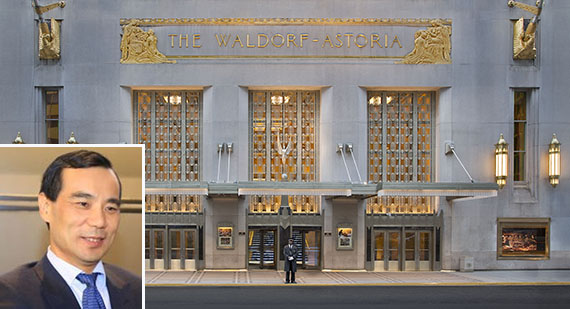Trending
Why Anbang’s condo conversion at the Waldorf makes sense
Chinese insurer would see cash infusion after its nearly $2B purchase of the iconic hotel

In 2004, after the Elad Group paid $675 million for The Plaza Hotel, it poured another $400 million into the iconic property and converted a portion of the rooms into private condominiums. In 2005, Taj Hotels and Resorts did the same when it acquired the Pierre, now home to 217 co-op units. Meanwhile, the newly-built Baccarat Residences includes 60 ultra-luxury condos atop the five-star hotel.
So it’s no surprise that Anbang Insurance Group, the new Chinese owner of the Waldorf Astoria, plans to take as many as 1,000 hotel rooms out of circulation to create high-end condos at the New York City landmark.
Yet the move comes as Chinese regulators question the insurer’s liquidity and business model and Manhattan’s $8 billion hotel industry last year showed signs of slowdown. All that piled on top of the core logistical challenges of operating a 1,400-key hotel like the Waldorf.
“They can’t have a five-star hotel with that many rooms,” a source who met with Anbang executives in New York said in an interview with The Real Deal. Instead, according to the source, the insurer intends to upgrade the remaining rooms into a high-end, boutique hotel that appeals to international (and Asian) travelers.
The average daily room rate (ADR) was $284 in 2015, down 1.2 percent compared to a year earlier, according to hospitality analytics firm STR. And revenue per available room (RevPar) dropped in 2015 by 1.9 percent to $245. Meanwhile, some 3,400 hotel rooms hit the market last year, and big name developers like Extell Development and the Witkoff Group are building luxury hotels.
But hospitality consultant Steven Kamali said it is unlikely Anbang is reducing the Waldorf’s key count because of current market conditions. “It would make sense that they are converting a portion of the guest rooms to condos, given their high cost basis,” he said. “This would be a thoughtful way to… make the investment plausible.”
Shifting a portion of the building onto the condo market gives Anbang short-term returns amid the reported investigation by the China Insurance Regulatory Commission.
Anbang’s recent buying spree not only included the nearly $2 billion purchase of the Waldorf, but also its $6.5 billion deal to buy Strategic Hotels & Resorts from the Blackstone Group. The insurer also mounted a $14 billion bid for Starwood Hotels & Resorts before abruptly pulling out of negotiations.
“They want to know where is the capital source,” said Eva Liu, an analyst at Z-Ben Advisors, a Shanghai-based consulting firm, referring to insurance regulators who reportedly sent inspectors to visit Anbang’s offices this spring. “They also want to know more about its business model, as an aggressive investor.”
It’s not just Anbang’s seemingly insatiable appetite for overseas investments that has raised questions. In particular, Liu said the insurer has ramped up its issuance of universal life insurance policies – a product that’s attracted investors looking to recoup their money within two years. “So if Anbang uses the money it is raising from universal products to do long-term investments, it will cause security risk,” Liu said.
In an interview with Chinese website Caixin last year, Anbang Chairman Wu Xiaohui said the company’s assets “far exceeded 1 trillion yuan, enough to carry out foreign investment.”
In fact, industry analysts say Anbang’s main capital source isn’t insurance, but equity investments. The company was launched in 2004 with $75.9 million in registered capital. Last year, investors poured about $7.5 billion into Anbang, whose registered capital topped $9.4 billion in 2015, up from $1.8 billion in 2014, making it one of the largest of China’s insurance companies, according to the Financial Times.
During a speech at Harvard last year, Wu said he expected strong returns on the Waldorf investment. “To achieve the high value-creation, we plan to renovate the two towers into luxury residential apartments with world-class amenities and finishes,” he said. “At the same time, we will build the hotel section into a super five-star hotel, delivering unparalleled customer experience.”
Developing condos at an iconic New York City hotel certainly has precedent – and one Wu alluded to at Harvard. “A comparable residential renovation project is The Plaza Hotel,” he said, “which has already made lucrative returns with a proven business model.”
A decade ago, Elad Properties converted The Plaza Hotel into 150 hotel rooms and 200 condos after buying the 805-room hotel for $675 million. In 2007 and 2008, buyers paid a median price of $3,636 per foot, according to CityRealty data.
But buyers these days are looking for the next shiny new thing, such as Macklowe Properties’ 432 Park Avenue, where apartments currently on the market are asking $8,486 per foot on average. Even at 15 Central Park West, apartments are asking $7,046 per foot on average. By contrast, the average asking price at The Plaza is $4,448 per foot, and sales over the past 12 months fetched $4,743 per foot. And then there’s the widely-speculated upon slowdown in Manhattan’s ultra-luxury market.
That’s not to say Anbang’s condo plans are doomed to fail.
Sales at new developments are expected to total about $10.3 billion in 2018, up from $5.4 billion in 2015 and $4.1 billion in 2014, according to a recent report from CityRealty. The report projected sales of $8.4 billion in 2016.
While fewer developers are building penthouses that cost $100 million and up, the report said, “condominium prices are still on an upward trajectory.”
Certain buyers will always be drawn to the brand-name of the Waldorf-Astoria, said Andy Gerringer, managing director of new business development at The Marketing Directors. “The big question,” he said, “is how large they plan to make the condos, what their expected absorption will be and what pricing they intend to ask.”




